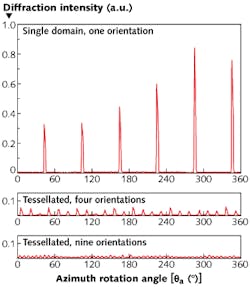Tessellation of moth-eye arrays drastically cuts backscattered diffraction
Surfaces that mimic the eyes and wings of some moth species with arrays of nanoscale features can be used as optical antireflection (AR) coatings. However, the artificial arrays themselves are usually regular over large regions, leading to backscattered diffraction and iridescence. Researchers at the University of Southampton (Southampton, England) are further drawing from the geometry of natural moth eyes to reduce this diffraction: They are creating hexagonal nanoscale arrays that have small regular areas with differing angular orientations (for example, 0°, 15°, 30°, and 45°) that spatially distribute the diffraction orders.
The researchers photolithographically fabricated three types of moth-eye-array geometries in silicon: first, a single-orientation array; second, a tessellated array with four different orientations (24-fold optical symmetry); and third, a tessellated array with nine different orientations (54-fold optical symmetry). The resulting nanoscale pillars (with a period of about 250 nm) were not optimized in shape for AR qualities, but for easy detection and measurement of diffracted orders. A setup with a xenon light source, rotation stages, a fiber collector, and a spectrometer was used to analyze the scatter. Various types of data were taken (for example, scattered light intensity at a wavelength of 418 nm as a function of azimuth angle, as in the figure), showing that the tessellated versions drastically reduced the intensity of individual diffraction orders. Contact Petros Stavroulakis at [email protected].
About the Author
John Wallace
Senior Technical Editor (1998-2022)
John Wallace was with Laser Focus World for nearly 25 years, retiring in late June 2022. He obtained a bachelor's degree in mechanical engineering and physics at Rutgers University and a master's in optical engineering at the University of Rochester. Before becoming an editor, John worked as an engineer at RCA, Exxon, Eastman Kodak, and GCA Corporation.

